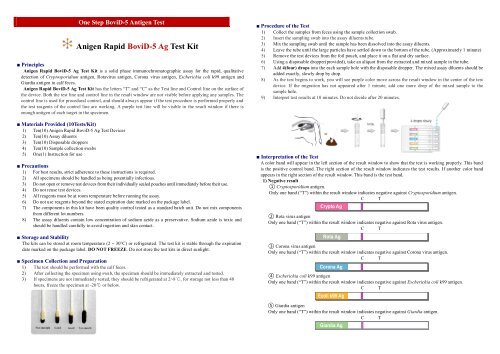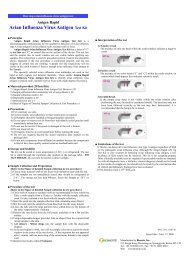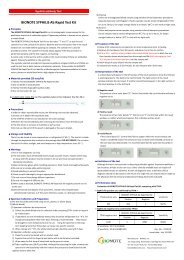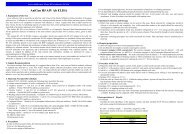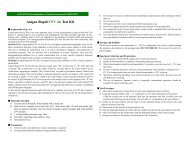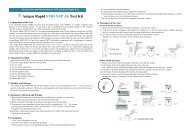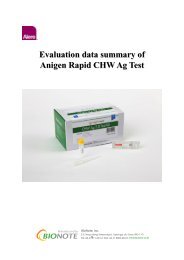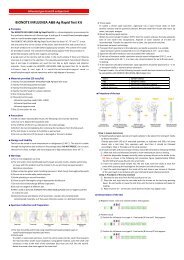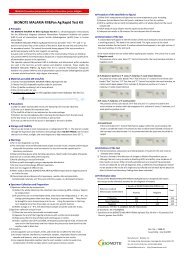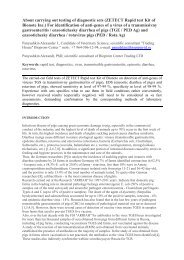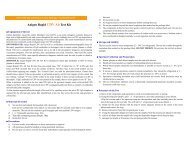SD BIOLINE Dengue Fever IgG and IgM Rapid Test
SD BIOLINE Dengue Fever IgG and IgM Rapid Test
SD BIOLINE Dengue Fever IgG and IgM Rapid Test
- No tags were found...
You also want an ePaper? Increase the reach of your titles
YUMPU automatically turns print PDFs into web optimized ePapers that Google loves.
One Step BoviD-5 Antigen <strong>Test</strong>Anigen <strong>Rapid</strong> BoviD-5 Ag <strong>Test</strong> Kit■ PrinciplesAnigen <strong>Rapid</strong> BoviD-5 Ag <strong>Test</strong> Kit is a solid phase immunochromatographic assay for the rapid, qualitativedetection of Cryptosporidium antigen, Rotavirus antigen, Corona virus antigen, Escherichia coli k99 antigen <strong>and</strong>Giardia antigen in calf feces.Anigen <strong>Rapid</strong> BoviD-5 Ag <strong>Test</strong> Kit has the letters “T” <strong>and</strong> “C” as the <strong>Test</strong> line <strong>and</strong> Control line on the surface ofthe device. Both the test line <strong>and</strong> control line in the result window are not visible before applying any samples. Thecontrol line is used for procedural control, <strong>and</strong> should always appear if the test procedure is performed properly <strong>and</strong>the test reagents of the control line are working. A purple test line will be visible in the result window if there isenough antigen of each target in the specimen.■ Materials Provided (10<strong>Test</strong>s/Kit)1) Ten(10) Anigen <strong>Rapid</strong> BoviD-5 Ag <strong>Test</strong> Devices2) Ten(10) Assay diluents3) Ten(10) Disposable droppers4) Ten(10) Sample collection swabs5) One(1) Instruction for use■ Precautions1) For best results, strict adherence to these instructions is required.2) All specimens should be h<strong>and</strong>led as being potentially infectious.3) Do not open or remove test devices from their individually sealed pouches until immediately before their use.4) Do not reuse test devices.5) All reagents must be at room temperature before running the assay.6) Do not use reagents beyond the stated expiration date marked on the package label.7) The components in this kit have been quality control tested as a st<strong>and</strong>ard batch unit. Do not mix componentsfrom different lot numbers.8) The assay diluents contain low concentration of sodium azide as a preservative. Sodium azide is toxic <strong>and</strong>should be h<strong>and</strong>led carefully to avoid ingestion <strong>and</strong> skin contact.■ Storage <strong>and</strong> StabilityThe kits can be stored at room temperature (2 ~ 30°C) or refrigerated. The test kit is stable through the expirationdate marked on the package label. DO NOT FREEZE. Do not store the test kits in direct sunlight.■ Specimen Collection <strong>and</strong> Preparation1) The test should be performed with the calf feces.2) After collecting the specimen using swab, the specimen should be immediately extracted <strong>and</strong> tested.3) If specimens are not immediately tested, they should be refrigerated at 2~8℃, for storage not less than 48hours, freeze the specimen at -20℃ or below.■ Procedure of the <strong>Test</strong>1) Collect the samples from feces using the sample collection swab.2) Insert the sampling swab into the assay diluents tube.3) Mix the sampling swab until the sample has been dissolved into the assay diluents.4) Leave the tube until the large particles have settled down to the bottom of the tube. (Approximately 1 minute)5) Remove the test devices from the foil pouch, <strong>and</strong> place it on a flat <strong>and</strong> dry surface.6) Using a disposable dropper(provided), take an aliquot from the extracted <strong>and</strong> mixed sample in the tube.7) Add 4(four) drops into the each sample hole with the disposable dropper. The mixed assay diluents should beadded exactly, slowly drop by drop.8) As the test begins to work, you will see purple color move across the result window in the center of the testdevice. If the migration has not appeared after 1 minute, add one more drop of the mixed sample to thesample hole.9) Interpret test results at 10 minutes. Do not decide after 20 minutes.■ Interpretation of the <strong>Test</strong>A color b<strong>and</strong> will appear in the left section of the result window to show that the test is working properly. This b<strong>and</strong>is the positive control b<strong>and</strong>. The right section of the result window indicates the test results. If another color b<strong>and</strong>appears in the right section of the result window. This b<strong>and</strong> is the test b<strong>and</strong>.1) Negative result1 Cryptosporidium antigen.Only one b<strong>and</strong> (“T”) within the result window indicates negative against Cryptosporidium antigen.C T2 Rota virus antigenOnly one b<strong>and</strong> (“T”) within the result window indicates negative against Rota virus antigen.C T3 Corona virus antigenOnly one b<strong>and</strong> (“T”) within the result window indicates negative against Corona virus antigen.C T4 Escherichia coli k99 antigenOnly one b<strong>and</strong> (“T”) within the result window indicates negative against Escherichia coli k99 antigen.C T5 Giardia antigenOnly one b<strong>and</strong> (“T”) within the result window indicates negative against Giardia antigen.C T
2) Positive result1 Cryptosporidium antigen.Two color b<strong>and</strong>s (“T” <strong>and</strong> “C”) within the result window of Crypto Ag indicate the presence ofCryptosporidium antigen.C T2 Rota virus antigenTwo color b<strong>and</strong>s (“T” <strong>and</strong> “C”) within the result window of Rota Ag indicate the presence of Rota virus antigen.C T■ Limitation of the <strong>Test</strong>1) This <strong>Test</strong> is for in-vitro diagnostic use only.2) This test detects the presence of Cryptosporidium antigen, Rotavirus antigen, Corona virus antigen. Escherichiacoli k99 antigen <strong>and</strong> Giardia antigen in the specimen <strong>and</strong> should not be used as the sole criterion for thediagnosis of them.3) As with all diagnostic tests, all results must be considered with other clinical information available to theveterinarian.4) For more accuracy of immune status, additional follow-up testing using other laboratory methods isrecommended.3 Corona virus antigenTwo color b<strong>and</strong>s (“T” <strong>and</strong> “C”) within the result window of Corona Ag indicate the presence of Corona virusantigen.C T4 Escherichia coli k99 antigenTwo color b<strong>and</strong>s (“T” <strong>and</strong> “C”) within the result window of E.coli k99 indicate the presence of Escherichia colik99 antigen.C T5 Giardia antigenTwo color b<strong>and</strong>s (“T” <strong>and</strong> “C”) within the result window of Giardia Ag indicate the presence of Giardia antigen.C T3) Invalid ResultIf the purple color b<strong>and</strong> is not visible within the result window after performing the test, the result is consideredinvalid. The directions may not have been followed correctly or the test may have deteriorated. <strong>Test</strong> should beperformed again.C T C TDoc. No.: I1302-01EIssued date: Dec. 3, 2012


